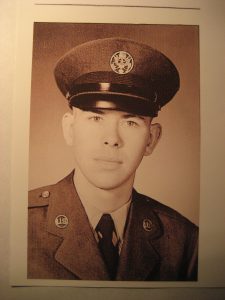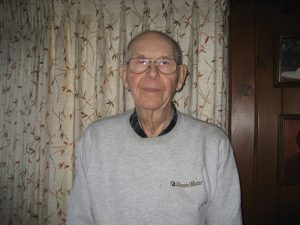Walton Van Maanen of Lynnville is a well-known native of the area, most notably for his 46-year career of ownership of Van’s Radio and TV. But before this, he served for four years in the U.S. Air Force during a time between the Korean and Vietnam Wars, part of “The Cold War Era.”
The Cold War was an extended time of heightened tension in the United States beginning after World War II, Van Maanen explained. The Soviet Union (USSR) and its other eastern European and Asian allies, collectively known as the Eastern Bloc, were perceived as a threat to the Western Bloc (the United States and NATO allies). The U.S. Air Force’s Strategic Air Command (SAC) constantly flew aircraft 24 hours a day, seven days a week, often refueling in the air. The United States military was determined to be prepared so another incident like Pearl Harbor would not occur.
Van Maanen had grown up on the family farm near Taintor, but knew he didn’t want to be a farmer in his adulthood. “My dad always said I was a tinkerer,” Van Maanen said, and on a cold January day in 1956, two weeks after he and his new bride, Violet, were married, he left for basic training in the United States Air Force.
The site of Van Maanen’s basic training was Parks Air Force Base (AFB) near Oakland, CA. Afterwards, he was sent to “engine school” at Sheppard AFB near Wichita Falls, TX, where he received several months of technical training, preparing him to serve with an MOS (Military Occupational Specialty) of Reciprocating Engine Mechanic. Violet was able to rejoin her husband while he was stationed at Sheppard AFB.
Those who received certification as a Reciprocating Engine Mechanic were qualified to work on gas engines attached to propellers, but not jets. As a result of this training, Airman Third Class (A/3C) Van Maanen was certified to work on all large and small gas engines, which meant he was able to work on both twin-engine and four-engine planes.
After he completed his tech school training, Van Maanen was assigned to the 802nd Aircraft Support Squadron at Schilling AFB in Salina, KS, a SAC airbase. The main purpose of this squadron was to bring supplies and parts for the maintenance and repair of B-47 Stratojet bombers and KC-97 Strato-freighter tankers based at Schilling. These met the need for aircraft presence in the skies on a constant basis. The B-47s were designed to fly at high altitudes and be prepared to serve as nuclear bombers capable of striking the Soviet Union if necessary, and the KC-97s were used for in-flight fueling of the B-47s. The Support Squadron maintained cargo planes, primarily used to serve the maintenance needs of the B-47s. These cargo planes at Schilling, all outfitted with gas engine propellers, included smaller C-45s and C-47s, as well as C-119s, which are large enough to drive a jeep into. Van Maanen worked on the engines of all these types of cargo planes at Schilling. The majority of them had been used in World War II or Korea. Notably, the C-119 carried paratroopers in World War II. Van Maanen explained that because meticulous records are kept of the number of flight hours for each plane, it is possible to determine the time when an engine should be rebuilt, extending the life and usefulness of the plane. At Schilling, the engines would be removed from the planes and sent to Tinker AFB, OK, to be rebuilt and then reinstalled afterwards back at Schilling.
After serving many months as an engine mechanic, an opportunity arose for Van Maanen to serve in a different role, as Crew Chief of a C-45 cargo plane. His new responsibilities included coordination of all maintenance to the plane to which he was assigned. He also took care of refueling the plane, inspecting it before and after flight, performing any repairs and maintenance of its engines, and coordinating with other shops for repairs of such things as tires or hydraulics. After being promoted to Airman First Class (A/1C), Crew Chief Van Maanen won an award of $25 (a lot of money in the 1950s, he commented) for having his plane in perfect order before takeoff, with no defects written up according to the pilot’s pre-flight checklist. This rare, commendable circumstance was known as an “initial,” and Van Maanen was recognized and awarded for his work with a “well done” by the Base Director of Operations.
Van Maanen made good use of his spare time during his time at Schilling, furthering his education by taking Air Force correspondence courses. He explained these were paper and pencil versions of courses people would take online over the internet today. Two of the courses he took were “Basic Vehicle Maintenance” and “Radio Fundamentals,” which gave Van Maanen a foundation for his success after he returned to civilian life.
Occasionally, Van Maanen would be sent off-base during his service at Schilling, including being assigned to temporary duty at other Air Force bases. He was sent to Forbes AFB near Topeka, KS, to study C-119 maintenance and to Pope AFB near Fayetteville, NC, to study C-123 cargo plane maintenance. Later, he was sent to White-man AFB near Knob Noster, MO, to teach their mechanics what he had learned about C-123s when he was a student at Pope AFB. Van Maanen commented that at that time, many of the SAC Air Force bases were created in isolated locations, so as to minimize harm to nearby civilians if the base were to be bombed or hit by a missile. Today, due to urban growth, many of these long-existing bases have become surrounded by the cities from which they were once separated.
Other duties Van Maanen performed at Schilling were unrelated to his specific position as an engine mechanic or crew chief, as was true for most of the other people stationed there. Depending on the time of year, he could be gathering and hauling tumbleweeds that accumulated around the parked planes and jets (four of them could fit into the back of a pickup), or manually shoveling snow from around the landing lights along the runway to prevent accidental damage from snowplows. And three or four times a year, an unannounced drill or “practice alert” would take place, often in the middle of the night, where the entire base would help load the B-47s as if they had been alerted to take off due to a combat situation.
“The B-47 pilots,” Van Maanen explained, “had their barracks situated right next to the runway and could be ready to fly their jets within three minutes, so the pace of the practice alert was predictably very fast.”
Van Maanen shared a funny story where his military life and farm life overlapped, or more accurately, didn’t. One day at Schilling, a plane needed to be towed, and this normally would be done by using a Clark tow tractor, commonly called a “tug.” However that day, the tug was out service due to it being repaired, and the motor pool’s only available alternative for the job was a Farmall tractor, painted in military colors of course. Even though Van Maanen, who was certified to drive the tug, had been a “farm boy” all his life prior to enlisting in the Air Force, certification for driving a tractor was not on his list of official certifications, so he had to prove that he was up to the task by driving the tractor around the motor pool before being deemed capable. It should give us some comfort, though, that the Air Force is as diligent as they are for assigning accountabilities, and Van Maanen indeed proved his accountability with flying colors.
After his four-year enlistment was up in early 1960, Van Maanen returned to civilian life and eventually started his radio and TV business. He was still part of the Air Force Reserve for two years, and later served from 1964-1966 as a radar repair technician at the Iowa Air National Guard Base in Des Moines on weekends and for two weeks of annual active duty. The radar units were part of the missile guidance system used by the F-89 fighter jets located at the base.
After retiring from his business in 2006, Van Maanen’s skills have still been actively utilized. He was the “maintenance man” for the Christian radio station KRNF 89.7, operated at the time by former pastor of the Lynnville Friends Church, Doug Smiley, until the station was sold. Van Maanen’s duties were to ensure that the station’s transmitter in Malcom operated in compliance with the FCC and often included such tasks as replacing fuses if the station unexpectedly went off the air or the tower lights went out because of a lightning strike. Van Maanen also spends time with his hobby of building miniature engines, whose larger counterparts might have been powered by steam, but the miniatures are run instead by using an air compressor. The precision millwork he performs in meticulously building these working engines is often done within thousandths of an inch. Always a tinkerer.
Our community thanks Walton Van Maanen for his time in the United States Air Force, Reserves, and Air National Guard.





